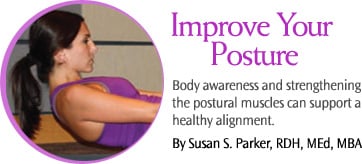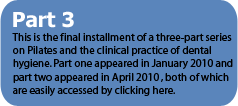
Improve Your Posture
Body awareness and strengthening the postural muscles can support a healthy alignment.
Understanding the body’s unique alignment is important to maintaining musculoskeletal health, particularly for oral health care workers who spend long periods of time in static and sometimes awkward postures. After years of ballet training in New York City, I developed an 
LISTEN TO YOUR BODY
About 80% of back and neck pain is caused by poor posture.2 A healthy postural alignment cre- ates a comfortable feeling throughout the entire body. If a day is spent working with poor body mechanics, muscle spasm and spinal misalignment may occur. The first step toward changing a bad postural habit is to recognize your own postural pitfalls.3
Good posture originates with a stance that enables the bones to fit correctly together at their respective joints. The way the bones fit in relationship to one another and to the whole body form is referred to as alignment. Pretend you are a marionette and can visualize each part connecting to another. This awareness of the body can help identify any imbalances. Mindful- ness of postural alignment is particularly important for dental hygienists because we often become so absorbed in our work that we don’t notice that our bodies are telling us something is wrong. Take a moment between each patient to be mindful of your alignment and listen to what your body is telling you.
|
|
To visualize ideal postural alignment, think of a line running down the center of the body where the spine is neu- tral and feet are placed shoulder-width apart. Knees should be slightly bent and the lower abdominal muscles engaged.4 Figure 1 illustrates the body stance of good posture in comparison to examples of poor posture.
THE PILATES METHOD
The Pilates method of body conditioning can improve alignment as well as breathing and circulation. Increased strength and flexibility will encourage proper posture. Pilates is more than just exercises. It engages the mind because the form and breathing used during Pilates exercise are criti- cal. You must concentrate on the movements to make them count.
Pilates strengthens one of the main postural muscles—the transversus abdominis, which wraps around the middle of the body and gives us a waist.5 The action of this important muscle compresses the abdomen to help support the abdominal viscera against the pull of gravity. When this muscle is weak, the lumbar spine is easily injured.
The Pilates exercise “the hundred” is a good start to strengthening the transversus abdominis. Part of almost every Pilates work- out, the hundred warms up the body and engages the abdominal muscles while also requiring a specific breathing technique. It is typically done with five inhaling breaths and five exhaling breaths 10 times, hence the name “hundred.”5
To begin the exercise, lie down on a mat with the knees bent at a 90° angle and holding both feet off the floor (Figure 2). Arms should be held above the abdominal muscles and par- allel to the floor. The head, neck, and shoul- ders should also be held above the floor, using the abdominal muscles to support them. The spine should remain in a neutral position. Next, move the arms up and down approxi- mately 2 inches to 3 inches in rhythm with a five-count inhale breath and then a five-count exhale breath while holding this position. As the abdominal muscles become stronger, the legs can be extended to a more challenging angle to increase difficulty (Figure 3 and Figure 4).
IN PRACTICE
We must reawaken our awareness of the organic relationships of the foot to the pelvis, pelvis to diaphragm, and diaphragm to the palate/cranium. To become more aware of postural align- ment, take a few moments throughout the day to visualize a marionette with the string com- ing out of the skull and lightly pulling the top of the head upward while the feet are firmly planted on the ground. The more you are aware of your posture, the easier it will become to main- tain a healthful alignment.
ACKNOWLEDGMENT
The author would like to thank Paul Caballero for the photography and Louisiana State University, School of Dentistry students Stephen Vutera, Rene Bourgeois, and Celeste Toups for modeling.
REFERENCES
- Jarney C. The Concise Book of Muscles. 2nd ed. Berkeley, Calif: North Atlantic Books; 2008.
- Valachi B, Valachi K. Mechanisms leading to musculoskeletal disorders in dentistry. J Am Dent Assoc. 2003;134:1344-1350.
- United States Pilates Association. Available at: www.unitedstatespilatesassociation.com. Accessed August 9, 2010.
- Calais-Germain B. Anatomy of Movement. Vista, Calif: Eastland Press; 1993.
- Pilates—The Hundred as a Great Warmup! Available at: www.pilates-back-joint-exercise.com/pilates-the-hundred.html. Accessed August 9, 2010.
From Dimensions of Dental Hygiene. September 2010; 8(9): 56, 59.





